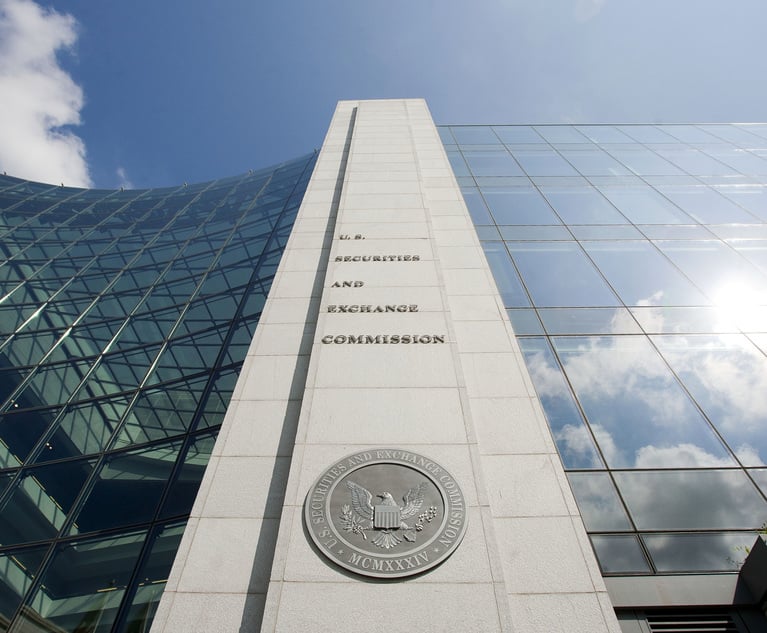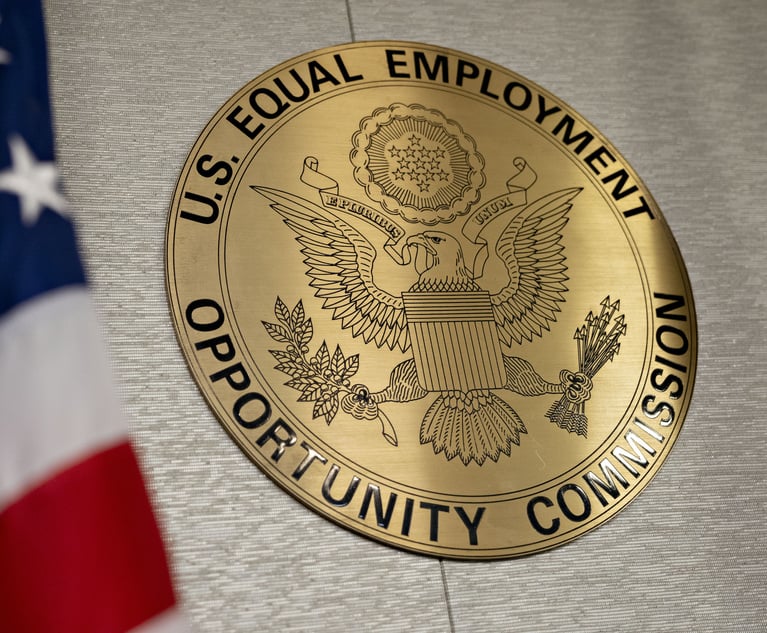Litigation: Predictive coding’s grand debut
Two recent cases involved protracted predictive coding disputes. Digging into those disputes highlights some of the technologys potential future problems and clarifies those instances and situations in which it may be put to appropriate use.
September 13, 2012 at 06:58 AM
4 minute read
The original version of this story was published on Law.com
Predictive coding is machine-learning technology that lets computers automatically predict how documents should be classified with limited human input. Some e-discovery commentators (and vendors) have spent the past few years touting the technology as the cure for all of e-discovery's ills.
But the technology's actual arrival to the world of litigation and discovery motions reveals that it is not without side effects. Two recent cases involved protracted predictive coding disputes. Digging into those disputes highlights some of the technology's potential future problems and clarifies those instances and situations in which it may be put to appropriate use.
Da Silva Moore v. Publicis Groupe: Proponent or prejudice?
Da Silva Moore v. Publicis Groupe is the first, and most high-profile, judicial opinion endorsing the use of computer-assisted coding—and a founding saga of the technology's potential areas of future dispute. The case is, essentially, a Title VII gender discrimination class action. Discovery in the matter, which is venued in the Southern District of New York, is being overseen by Magistrate Judge Andrew Peck, who has been a leading proponent of predictive coding for some time. In addition to appearing at industry conferences as a speaker, Judge Peck wrote an article called “Search, Forward” in which he advocated use of computer-assisted review technologies and said the article itself could serve as a “sign of judicial approval of predictive coding” in appropriate cases.
The parties in Da Silva Moore initially agreed to use predictive coding; however, negotiations over a mutually agreeable protocol for programming the coding technology eventually broke down. Plaintiffs argued that the court erred in accepting the defendant's recommended protocol, which they contend is flawed. As a result, discovery was stayed and plaintiffs moved for Judge Peck's recusal, arguing his support of the technology and relationships with its vendors have made him biased. Judge Peck denied plaintiff's requests to recuse himself. Judge Andrew Carter, the presiding district court judge in the case, is now considering the plaintiffs' objections to Judge Peck's orders denying recusal and concerning the parameters of the predictive coding protocol.
Kleen Products v. Packaging Corp. of America: You can't make me
In Kleen Products v. Packaging Corp. of America, an antitrust matter set in the Northern District of Illinois, the plaintiffs asked that the defendants redo their document production and all future productions using predictive coding technology. The plaintiffs argued that use of the method would realize more thorough results than those provided by defendants' keyword search technology. This request, however, came after defendants had already spent thousands of hours reviewing documents and had produced more than one million documents.
After hearing expert witness testimony on the sufficiency of the initial production, Magistrate Judge Nan Nolan asked the parties to reach a compromise on keyword searches. In comments on the record, Judge Nolan confirmed the parties cannot dictate what technology their opponent may use without indicating how document production results are insufficient or inaccurate. Subsequently, in a recent stipulation and order, the plaintiffs withdrew their demand.
Conclusion: Predictive coding predictions
Predictive coding is here to stay, and disputes about its uses and limitations are sure to add to the e-discovery bill for at least some of its early adopters. Potential areas of dispute include not only use of the technology in general but also the specifics of operating and programming protocols, even if everyone agrees to use the technology.
For the time being, the availability of predictive coding has not yet displaced other commonly accepted e-discovery methods such as keyword searches, nor will it anytime soon. Despite the fact that predictive coding is fast becoming an accepted technology for e-discovery, its availability is not the basis for challenging appropriate uses of other e-discovery methods, including standard keyword search technology. As a result, the selection of the technology (or technologies) to be used for e-discovery remains an important strategic choice with the potential to impact both the cost and duration of litigation.
This content has been archived. It is available through our partners, LexisNexis® and Bloomberg Law.
To view this content, please continue to their sites.
Not a Lexis Subscriber?
Subscribe Now
Not a Bloomberg Law Subscriber?
Subscribe Now
NOT FOR REPRINT
© 2025 ALM Global, LLC, All Rights Reserved. Request academic re-use from www.copyright.com. All other uses, submit a request to [email protected]. For more information visit Asset & Logo Licensing.
You Might Like
View All

Trending Stories
- 1Crypto Hacker’s $65 Million Scam Ends in Indictment
- 2Trump's Inspectors General Purge Could Make Policy Changes Easier, Observers Say
- 3Supporting Our Supreme Court Justices in the Guardianship Part
- 4'Erroneous Rulings'?: Wilmer Asks 4th Circuit to Overturn Mosby's Criminal Convictions
- 5Judge Orders Acquittal of Ex-Prosecutor on 1 of 2 Counts in Misconduct Trial Over Ahmaud Arbery Case
Who Got The Work
J. Brugh Lower of Gibbons has entered an appearance for industrial equipment supplier Devco Corporation in a pending trademark infringement lawsuit. The suit, accusing the defendant of selling knock-off Graco products, was filed Dec. 18 in New Jersey District Court by Rivkin Radler on behalf of Graco Inc. and Graco Minnesota. The case, assigned to U.S. District Judge Zahid N. Quraishi, is 3:24-cv-11294, Graco Inc. et al v. Devco Corporation.
Who Got The Work
Rebecca Maller-Stein and Kent A. Yalowitz of Arnold & Porter Kaye Scholer have entered their appearances for Hanaco Venture Capital and its executives, Lior Prosor and David Frankel, in a pending securities lawsuit. The action, filed on Dec. 24 in New York Southern District Court by Zell, Aron & Co. on behalf of Goldeneye Advisors, accuses the defendants of negligently and fraudulently managing the plaintiff's $1 million investment. The case, assigned to U.S. District Judge Vernon S. Broderick, is 1:24-cv-09918, Goldeneye Advisors, LLC v. Hanaco Venture Capital, Ltd. et al.
Who Got The Work
Attorneys from A&O Shearman has stepped in as defense counsel for Toronto-Dominion Bank and other defendants in a pending securities class action. The suit, filed Dec. 11 in New York Southern District Court by Bleichmar Fonti & Auld, accuses the defendants of concealing the bank's 'pervasive' deficiencies in regards to its compliance with the Bank Secrecy Act and the quality of its anti-money laundering controls. The case, assigned to U.S. District Judge Arun Subramanian, is 1:24-cv-09445, Gonzalez v. The Toronto-Dominion Bank et al.
Who Got The Work
Crown Castle International, a Pennsylvania company providing shared communications infrastructure, has turned to Luke D. Wolf of Gordon Rees Scully Mansukhani to fend off a pending breach-of-contract lawsuit. The court action, filed Nov. 25 in Michigan Eastern District Court by Hooper Hathaway PC on behalf of The Town Residences LLC, accuses Crown Castle of failing to transfer approximately $30,000 in utility payments from T-Mobile in breach of a roof-top lease and assignment agreement. The case, assigned to U.S. District Judge Susan K. Declercq, is 2:24-cv-13131, The Town Residences LLC v. T-Mobile US, Inc. et al.
Who Got The Work
Wilfred P. Coronato and Daniel M. Schwartz of McCarter & English have stepped in as defense counsel to Electrolux Home Products Inc. in a pending product liability lawsuit. The court action, filed Nov. 26 in New York Eastern District Court by Poulos Lopiccolo PC and Nagel Rice LLP on behalf of David Stern, alleges that the defendant's refrigerators’ drawers and shelving repeatedly break and fall apart within months after purchase. The case, assigned to U.S. District Judge Joan M. Azrack, is 2:24-cv-08204, Stern v. Electrolux Home Products, Inc.
Featured Firms
Law Offices of Gary Martin Hays & Associates, P.C.
(470) 294-1674
Law Offices of Mark E. Salomone
(857) 444-6468
Smith & Hassler
(713) 739-1250







